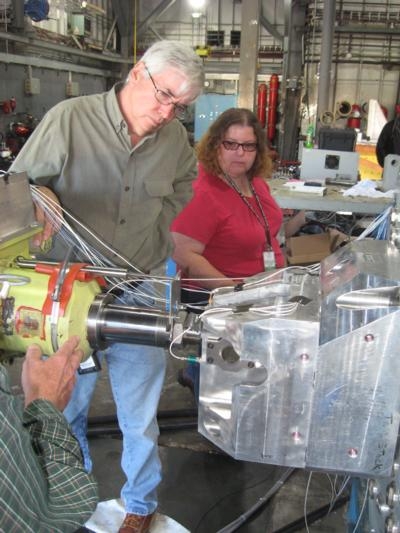Thrust Vector Control Actuators Undergoing Vibration Testing
There's a whole lotta shakin' going on at the Redstone Test Center in Alabama for NASA's new mega rocket, the Space Launch System (SLS).

SLS will be the most powerful rocket ever built for deep space missions, including to an asteroid and eventually Mars.
NASA and The Boeing Co., prime contractor for the SLS core stage, have teamed up for thrust vector control actuator vibration testing with the Redstone Test Center's Dynamic Test Division on Redstone Arsenal in Huntsville, Alabama. The actuators are hydraulic-powered, piston-like motors that control the RS-25 engine gimbal position to change the engine thrust angle with respect to the SLS core stage. The core stage, towering more than 200 feet, will store cryogenic liquid hydrogen and liquid oxygen that will feed the rocket’s RS-25 engines.
SLS will use actuators from the Space Shuttle Program, but with modifications. "Vibrations from launch can significantly impact the vehicle and its systems, which is why it's important to understand and mitigate those issues before we get to the pad," said Jonathan Looser, SLS core stage main propulsion system and thrust vector control lead at NASA's Marshall Space Flight Center in Huntsville, where the SLS Program is managed for the agency. "The SLS vibration levels on the actuators are significantly higher than the levels the shuttle experienced. We determined in the design process that the effects of the higher vibrations can be alleviated by adding stiffer springs to the actuator's mechanical feedback."
Development testing to evaluate the spring modification was completed in May 2014. A second phase of testing was completed in September 2014 to see how the new hardware performed under SLS flight conditions. A loaded actuator test series began in January, in which the actuator is placed onto a shaker table with up to 16,000 pounds of force added to the hardware during vibration. The test series, scheduled to conclude at the end of February, will provide data on how the actuator is affected by the vibrations and confirm its performance in the higher SLS environments.

"The size and control capability of the large shaker tables available at the Redstone Test Center provides an affordable and faster test option than if Marshall chose to develop the capability internally," said Chad Bryant, propulsion manager in the Stages Office at Marshall. "We are proud to partner with RTC to get this hardware ready for the first flight of SLS."
That first flight test will feature a configuration for a 70-metric-ton (77-ton) lift capacity and carry an uncrewed Orion spacecraft beyond low-Earth orbit to test the performance of the integrated system. As the SLS evolves, it will provide an unprecedented lift capability of 130 metric tons (143 tons) to enable missions even farther into our solar system.
(Images provided by NASA. Top: NASA Marshall's Roger Parisa and Miranda Holton get the thrust vector control actuator ready for vibration testing. Bottom: Location of the thrust vector control actuators on the SLS RS-25 engine.)
 ANN's Daily Aero-Linx (05.02.24)
ANN's Daily Aero-Linx (05.02.24) ANN's Daily Aero-Term (05.02.24): Touchdown Zone Lighting
ANN's Daily Aero-Term (05.02.24): Touchdown Zone Lighting Aero-News: Quote of the Day (05.02.24)
Aero-News: Quote of the Day (05.02.24) ANN FAQ: Contributing To Aero-TV
ANN FAQ: Contributing To Aero-TV NTSB Final Report: Cirrus Design Corp SR20
NTSB Final Report: Cirrus Design Corp SR20




